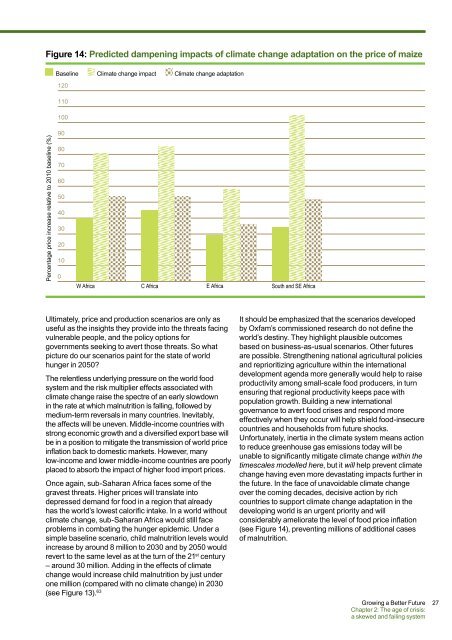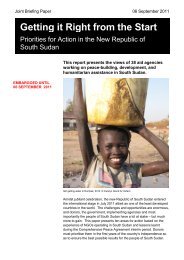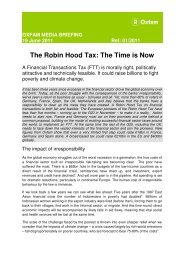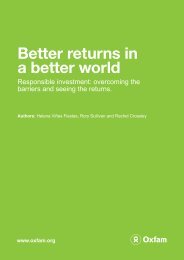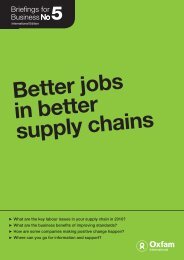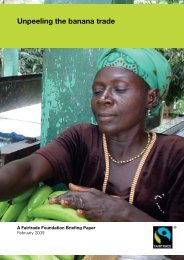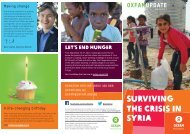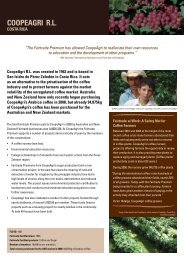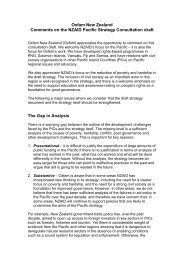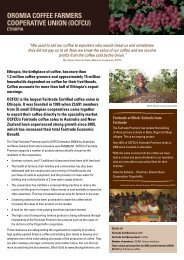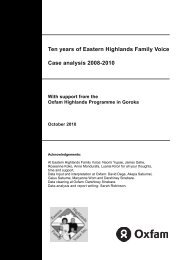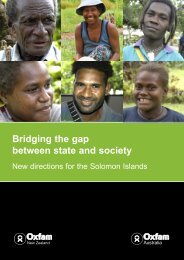Growing a Better Future - Oxfam International
Growing a Better Future - Oxfam International
Growing a Better Future - Oxfam International
- No tags were found...
You also want an ePaper? Increase the reach of your titles
YUMPU automatically turns print PDFs into web optimized ePapers that Google loves.
Figure 14: Predicted dampening impacts of climate change adaptation on the price of maizeBaseline120Climate change impact Climate change adaptation110100Percentage price increase relative to 2010 baseline (%)9080706050403020100W Africa C Africa E Africa South and SE AfricaUltimately, price and production scenarios are only asuseful as the insights they provide into the threats facingvulnerable people, and the policy options forgovernments seeking to avert those threats. So whatpicture do our scenarios paint for the state of worldhunger in 2050?The relentless underlying pressure on the world foodsystem and the risk multiplier effects associated withclimate change raise the spectre of an early slowdownin the rate at which malnutrition is falling, followed bymedium-term reversals in many countries. Inevitably,the affects will be uneven. Middle-income countries withstrong economic growth and a diversified export base willbe in a position to mitigate the transmission of world priceinflation back to domestic markets. However, manylow-income and lower middle-income countries are poorlyplaced to absorb the impact of higher food import prices.Once again, sub-Saharan Africa faces some of thegravest threats. Higher prices will translate intodepressed demand for food in a region that alreadyhas the world’s lowest calorific intake. In a world withoutclimate change, sub-Saharan Africa would still faceproblems in combating the hunger epidemic. Under asimple baseline scenario, child malnutrition levels wouldincrease by around 8 million to 2030 and by 2050 wouldrevert to the same level as at the turn of the 21 st century– around 30 million. Adding in the effects of climatechange would increase child malnutrition by just underone million (compared with no climate change) in 2030(see Figure 13). 63It should be emphasized that the scenarios developedby <strong>Oxfam</strong>’s commissioned research do not define theworld’s destiny. They highlight plausible outcomesbased on business-as-usual scenarios. Other futuresare possible. Strengthening national agricultural policiesand reprioritizing agriculture within the internationaldevelopment agenda more generally would help to raiseproductivity among small-scale food producers, in turnensuring that regional productivity keeps pace withpopulation growth. Building a new internationalgovernance to avert food crises and respond moreeffectively when they occur will help shield food-insecurecountries and households from future shocks.Unfortunately, inertia in the climate system means actionto reduce greenhouse gas emissions today will beunable to significantly mitigate climate change within thetimescales modelled here, but it will help prevent climatechange having even more devastating impacts further inthe future. In the face of unavoidable climate changeover the coming decades, decisive action by richcountries to support climate change adaptation in thedeveloping world is an urgent priority and willconsiderably ameliorate the level of food price inflation(see Figure 14), preventing millions of additional casesof malnutrition.<strong>Growing</strong> a <strong>Better</strong> <strong>Future</strong>Chapter 2: The age of crisis:a skewed and failing system27


